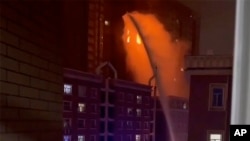Authorities in China's western Xinjiang region opened up some neighborhoods in the capital of Urumqi on Saturday after residents held extraordinary late-night demonstrations against the city's zero-COVID lockdown that had lasted more than three months.
The displays of public defiance were fanned by anger over a fire in an apartment compound that killed 10 people, according to the official death toll, as emergency workers took three hours to extinguish the blaze — a delay many attributed to obstacles caused by anti-virus measures.
The demonstrations, as well as public anger online, are the latest signs of building frustration with China's intense approach to controlling COVID-19. It's the only major country in the world that still is fighting the pandemic through mass testing and lockdowns.
Doors chained shut
During Xinjiang's lockdown, some residents elsewhere in the city have said their doors were chained physically shut, including one who spoke to The Associated Press who declined to be named for fear of retribution. Many in Urumqi believe such brute-force tactics may have prevented residents from escaping the fire and that the official death toll was an undercount.
Officials denied the accusations, saying there were no barricades in the building and that residents were permitted to leave. Police clamped down on dissenting voices, announcing the arrest of a 24-year-old woman for spreading "untrue information" about the death toll online.
Anger boiled over after Urumqi city officials held a press conference about the fire in which they appeared to shift responsibility for the deaths onto the apartment tower's residents.
"Some residents' ability to rescue themselves was too weak," said Li Wensheng, head of Urumqi's fire department.
In the protest, people in Urumqi largely marched peacefully in big puffy winter jackets in the cold winter night.
Videos of it featured people holding the Chinese flag and shouting "Open up, open up." They spread rapidly on Chinese social media despite heavy censorship. Some of the videos show people shouting and pushing against rows of men wearing the white whole-body hazmat suits that local government workers and pandemic-prevention volunteers wear.
By Saturday, most of the images had been deleted by censors. The Associated Press could not independently verify all the videos, but two Urumqi residents who declined to be named out of fear of retribution said large-scale protests occurred Friday night. One of them said he had friends who participated.
The AP pinpointed the locations of two of the videos of the protests in different parts of Urumqi. In one video, police in face masks and hospital gowns faced off against shouting protesters. In another, one protester is speaking to a crowd about their demands. It is unclear how widespread the protests were.
Speaking out is risky
Given China's vast security apparatus, protests are risky anywhere in the country, but they are extraordinary in Xinjiang, which for years has been the target of a brutal security crackdown. A huge number of Uyghurs and other largely Muslim minorities have been swept into a vast network of camps and prisons, instilling fear that grips the region to this day.
Most of the protesters visible in the videos were Han Chinese. A Uyghur woman living in Urumqi said it was because Uyghurs were too afraid to take to the streets despite their rage.
"Han Chinese people know they will not be punished if they speak against the lockdown," she said, declining to be named for fear of retaliation against her family. "Uyghurs are different. If we dare say such things, we will be taken to prison or to the camps."
In one video, which the AP could not independently verify, Urumqi's top official, Yang Fasen, told angry protesters he would open up low-risk areas of the city the following morning.
That promise was realized on Saturday, as Urumqi authorities announced that residents of low risk areas would be allowed to move freely within their neighborhoods. Still, many other neighborhoods remain under lockdown.
Officials also triumphantly declared Saturday that they had basically achieved "societal zero-COVID," meaning that there was no more community spread and that new infections were being detected only in people already under health monitoring, such as those in a centralized quarantine facility.
Social media users greeted the news with disbelief and sarcasm. "Only China can achieve this speed," wrote one user on Weibo.
Many in Xinjiang have been locked down since August. Most have not been allowed to leave their homes, and some have reported dire conditions, including spotty food deliveries that have caused residents to go hungry. On Friday, the city reported 220 new cases, the vast majority of which were asymptomatic.
The Uyghur woman in Urumqi said she had been trapped in her apartment since August 8 and was not allowed to even open her window. On Friday, residents in her neighborhood defied the order, opening their windows and shouting in protest. She joined in.
"No more lockdowns!" they screamed. "No more lockdowns!"
